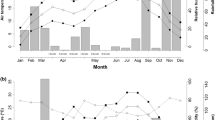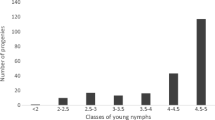Abstract
Inheritance of downy mildew [Sclerospora graminicola (Sacc.) Schrot]resistance was studied using generation mean analysis in pearl millet [Pennisetum glaucum (L.) R.Br.]. Eleven basic generations, namely, P1, P2, F1, F2, B1, B2, B1F2, B2F2, L1, L2 and L3 of three crosses involving six diverse lines for downy mildew incidence were evaluated under artificial epiphytotic conditions over two environments. The downy mildew incidence was best fitting for digenic, trigenic and tetragenic ratios when fitted into classical Mendelian ratios demonstrating involvement of two or more genes. Digenic and trigenic interaction models were adequate in the case of crosses I and III respectively, to account for the total variability in generation means. Unlike severity, comparative estimates of gene effects over two environments were mostly consistent in all crosses for prevalence. Most of the epistatic and major gene effects were found significant in all crosses for both the disease traits. Non-allelic interactions particularly at three-gene loci viz., w (additive × additive × additive) and y (additive × dominance × dominance) in cross II and all trigenic interactions in cross III were predominant. Duplicate dominance (cross I) and complementary epistasis (crosses II and III) were observed for both the traits revealing inconsistency of gene effects over crosses. The gd1 (interaction of additive gene effect with e1) and gh1(interaction of dominant gene effect with e1) were significant in crosses I and II, indicating interaction of additive and dominance gene effects with environments. Thus a breeding method that can mop up the resistant genes to form superior gene constellations interacting in a favorable manner against pathotype I would be more suitable to accelerate the pace of resistance improvement.
Similar content being viewed by others
References
Anand Kumar, K., R.P. Jain & S.D. Singh, 1983. Downy mildew reactions in pearl millet lines with and without cytoplasmic male sterility. Plant Dis 67: 663–665.
Andrews, D.J., S.B. King, J.R. Witcombe (Sic), S.D. Singh, K.N. Rai, R.P. Thakur, B.S. Talukdar, S.B. Chavan & P. Singh, 1985. Breeding for disease resistance and yield in pearl millet. Field Crops Res 11: 241–258.
Anonymous, 1996. Food from thought: A series of narratives on the practical application of research conducted by ICRISAT and its collaborators. No.3. Improving the unimprovable - succeeding with pearl millet. ICRISAT Center, Patencheru, Hyderabad. A.P. India.
Basavaraju, R., K.M. Safeeulla & B.R. Murthy, 1980. The role of gene effects and heterosis for resistance to downy mildew in pearl millet. Ind J Genet Pl Breed 140(3): 537–548.
Bucio Alanis, L.J., M. Perkins & J.L. Jinks, 1969. Environmental and genotype-environmental components of variability V. Segregating generations. Heredity 24: 115–117.
Campbell, K.W. & D.G. White, 1995. Inheritance of resistance to Aspergillus ear rot and aflatoxin in corn genotypes. Phytopathol 85: 886–896.
Carson, M.L. & A.L. Hooker, 1981. Inheritance of resistance to anthracnose leaf blight in five inbred lines of corn. Phytopathol 71: 488–491.
Cavalli, L.L., 1952. An analysis of linkage in quantitative inheritance. In: E.C.R. Reeve & C.H. Waddington (Eds.), Quantitative Inheritance, pp. 135–144. H.M.S.O., London.
Compstock, R.E. & R.H. Moll, 1963. Genotype-environment interaction. Proc Symp Statistical Genet and Pl Breed NAS-NRC, Washington, DC. Publ. No. 982: pp. 142–196.
Dass, S., R.L. Kapoor, R.S. Paroda & D.S. Jatsara. 1984. Gene effects for downy mildew (Sclerospora graminicola) resistance in pearl millet. Indian J Genet 44(2): 280–285.
Deswal D.P. & O.P. Govila, 1994. Genetics of disease resistance to downy mildew (Sclerospora graminicola) in pearl millet (Pennisetum glaucum (L.) R.Br.). Indian J Agric Sci 64(9): 661–663.
Deswal D.P., O.P. Govila & R.K. Sheoran, 1998. Genetic analysis of downy mildew resistance in pearl millet. Indian Phytopath 51(3): 261–264.
Geiger H.H. & M. Heun, 1989. Genetics of quantitative resistance to fungal diseases. Ann Rev Phytopathol 27: 317–341.
Gomez, A.A. & K.A. Gomez, 1984. Statistical procedures for agricultural research, 2nd edn. John Wiley and Sons, New York.
Hash, C.T., J.R. Witcombe, R.P. Thakur, S.K. Bhatnagar, S.D. Singh & J.P. Wilson, 1996. Breeding for pearl millet resistance. Proc Int Conf Genet Improvement of Sorghum and Pearl Millet. INTSORMIL & ICRISAT, Sep. 22-27. Texas. Publication No. 97(5): pp. 337–372.
Hayman, B.I., 1958. The separation of epistasis from additive and dominance variation in generation means I. Heredity 12: 371–390.
Hayman, B.I., 1960. The separation of epistasis from additive and dominance variation in generation means II. Genetica 31: 133–146.
Hill, J., 1966. Recurrent backcrossing in the study of quantitative inheritance. Heredity 21: 85–120.
Jones, E., 1994. Mapping Quantitative Trait Loci for Resistance to Downy Mildew. Ph.D. thesis. School of Biological Sciences, University of Wales, Bangore Gnedd, UK. pp. 147–151.
Jones, E.S., C.J. Liu, M.D. Gale, C.T. Hash & J.R. Witcombe, 1995. Mapping quantitative trait loci for downy mildew resistance in pearl millet. Theor Appl Genet 91: 448–456.
Kataria, R., H.P. Yadav, Sain Dass & S. Dass, 1993. Inheritance of downy mildew resistance in pearl millet. Agric Sci Dig 13(3/4): 128–130.
Kataria, R., H.P. Yadav, C.R. Beniwal & M.S. Nalarwal, 1994. Genetics of inheritance of downy mildew (Sclerospora graminicola) in pearl millet (Pennisetum glaucum). Indian J Agric Sci 64(9): 664–669.
Kempthorne, O., 1957. An introduction to genetical statistics. Wiley, New York.
Mather, K., 1949. Biometrical genetics. Dover Publication, 1st Edn., Methuen, London.
Michelmor, R.W., M.N. Pawar & R.J. Williams. 1982. Heterothallism in Sclerospora graminicola. Phytopathol 72: 1368–1372.
Rai, K.N. & K. Anand Kumar, 1994. Pearl millet improvement at ICRISAT an update. Int Sorghum and Millets Newsl 35: 1–29.
Rai, K.N., B.S. Talukdar, S.D. Singh, A.S. Rao, A.M. Rao & D.J. Andrews, 1994. Registration of ICMP 423 parental line of pearl millet. Crop Sci 34: 1430.
Safeeulla, K.M., 1977. Genetic vulnerability: the basic of recent epidemics in India. Ann NY Acad Sci 287: 72–85.
Sastry, J.G., S. Sivaramakrishinan, R.P. Thakur, V.S. Gupta & P.K. Ranjekar, 1997. Characterization of the genome of Sclerospora graminicola, the causal fungus of downy mildew of pearl millet. World J Microbiol Biotechnol 13(6): 693–697.
Shetty H.S., 1998. Strategies for Pearl Millet Downy Mildew Disease Management. Invited paper presented at the XXXIII workshop of the All India Co-ordianted Pearl Millet Improvement Project Group meeting at Fruit Research Station, Aurangabad, April 10-11.
Singh, F., R.M. Singh, R.B. Singh & R.K. Singh, 1980. Genetic studies of downy mildew resistance in pearl millet. In: V.P. Gupta & J.L. Minocha (Eds.), Trends in Genetic Research of Pennisetum spp., pp. 171–172. Wesley Press, Ludhiana, India.
Singh, S.D., 1974. Studies on downy mildew disease (Sclerospora graminicola (Sacc.) Scrot.) of bajra, Pennisetum typhoides (Brum. F.) Stapf & C.F. Hubb). PhD Thesis, Indian Agri Res Inst, New Delhi, India, pp. 126.
Singh, S.D., 1994. Recycling of discarded cultivars for the control of downy mildew in pearl millet. Indian J Plant Prot 22: 165–169.
Singh, S.D., 1995. Downy mildew of pearl millet. Plant Dis 79: 545–550.
Singh, S.D. & S.B. King, 1988. Recovery resistance to downy mildew in pearl millet. Plant Dis 77: 425–428.
Singh, S.D. & B.S. Talukdar, 1998. Inheritance of complete resistance to pearl millet downy mildew. Plant Dis 82: 791–793.
Singh, S.D., S. Ball & D.P. Thakur, 1987. Problems and strategies in the control of downy mildew. In: Proc Int Pearl MilletWorkshop, 7-11 April, ICRISAT, India, pp. 161–172.
Singh, S.D., S.B. King & J. Werder, 1993. Downy mildew disease of pearl millet. ICRISAT Inform Bull 37.
Singh, S.D., R.J. Williams & P. Malla Reddy, 1988. Isolation of downy mildew resistant lines from a highly susceptible cultivar of pearl millet. Indian Phytopathol 41: 450–456.
Singh, S.D., P. Singh, D.J. Andrews, B.S. Talukdar & S.B. King, 1992. Reselection of pearl millet cultivar utilizing residual variability for downy mildew reaction. Plant Breed 109: 54–59.
Talukdar B.S., S.D. Singh & C.T. Hash, 1994. Breeding for resistance to disease in pearl millet. In: H.G. Singh, S.N. Mishra, T.B. Singh, Hari Har Ram & D.P. Singh (Eds.), Crop Breeding in India, pp. 176–185. Int Book Distr Co. Lucknow, U.P. 226004, India.
Thakur, R.P., K.G. Shetty & S.B. King, 1992. Selection for host specific virulence in asexual populations of Sclerospora graminicola. Plant Pathol 41: 626–632.
Williams, R.J., 1984. Disease resistance in pearl millet. Rev Trop Plant Pathol 1: 245–296.
Williams, R.J., S.D. Singh & R.P. Thakur, 1976. Rating scales and standard drawings for incidence and severity assessment of pearl millet disease. 1: Downy mildew, Ergot, Smut, Cereal Improvement Program ICRISAT, Hyderabad, India.
Williams, R.J. & D.J. Andrews, 1983. Breeding for disease and pest resistance in pearl millet. FAO Plant Prot Bull 31: 136–158.
Yadav, O.P., 1994. Influence of A1 cytoplasm in pearl millet. Rev art Plant Breed Abstr 64: 1375–1379.
Yadav, O.P., 1996. Downy mildew incidence of pearl millet hybrids with different male sterility including cytoplasms. Theor Appl Genet 92: 278–280.
Yadav, O.P., V.K. Manga & G.K. Gupta, 1993. Influence of A1 cytoplasmic substitution on downy mildew incidence in pearl millet. Theor Appl Genet 87: 558–560.
Author information
Authors and Affiliations
Rights and permissions
About this article
Cite this article
Joshi, V., Ugale, S. Involvement of higher order interactions addressing complex polygenetically controlled inheritance of downy mildew [Sclerospora graminicola (Sacc.) Schrot] resistance in pearl millet [Pennisetum glaucum (L.) R.Br.]. Euphytica 127, 149–161 (2002). https://doi.org/10.1023/A:1020220309074
Issue Date:
DOI: https://doi.org/10.1023/A:1020220309074




